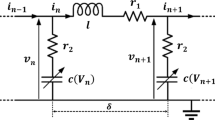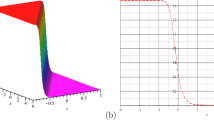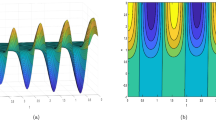Abstract
The paraxial nonlinear Schrödinger equation finds diverse applications in the fields of nonlinear optics, optical communication systems, plasma physics, and mathematical physics. The outcomes of this research endeavor are directed toward achieving three principal objectives. Firstly, one of our key aims is to uncover novel soliton solutions for the model, thereby making a valuable addition to the existing body of research. Secondly, we delve into the dynamics of these solutions using the modified extended auxiliary equation mapping approach, a methodology that provides valuable insights into the system's behavior. Our final objective involves an examination of the model's dynamic characteristics, achieved through bifurcation and stability analyses, as well as the identification of the associated Hamiltonian function. The presentation of three-dimensional and contour plots, with the parameter values having been thoughtfully chosen, is done for the purpose of ensuring the physical validity of our findings. These findings shed light on the practicability, efficacy, and computing speed of the methodologies that were utilized, delivering answers that are comprehensive and trustworthy. This research significantly enhances the field by advancing our comprehension of soliton solutions within the model, introducing innovative investigative techniques, and conducting a comprehensive exploration of the system's bifurcation and stability aspects. As a direct outcome of this study, new avenues have emerged for further exploration and potential application in the realms of nonlinear optics, optical communication systems, and related fields.










Similar content being viewed by others
Data availability
The data that support the findings of this study are available from the corresponding author upon reasonable request.
References
Adeyemo, O.D., Khalique, C.M.: Shock waves, periodic, topological kink and singular soliton solutions of a new generalized two dimensional nonlinear wave equation of engineering physics with applications in signal processing, electromagnetism and complex media. Alex. Eng. J. 73, 751–769 (2023). https://doi.org/10.1016/j.aej.2023.04.049
Ali, K., Rizvi, S.T.R., Nawaz, B., Younis, M.: Optical solitons for paraxial wave equation in Kerr media. Mod. Phys. Lett. B 33, 1950020 (2019). https://doi.org/10.1142/S0217984919500209
Arafat, S.M.Y., Islam, S.M.R., Rahman, M.M., Saklayen, M.A.: On nonlinear optical solitons of fractional Biswas-Arshed model with beta derivative. Results Phys. 48, 106426 (2023). https://doi.org/10.1016/j.rinp.2023.106426
Arafat, S.M.Y., Khan, K., Islam, S.M.R., Rahman, M.M.: Parametric effects on paraxial nonlinear Schrödinger equation in Kerr media. Chin. J. Phys. 83, 361–378 (2023). https://doi.org/10.1016/j.cjph.2022.08.026
Arshad, M., Seadawy, A.R., Lu, D., Khan, F.U.: Optical solitons of the paraxial wave dynamical model in kerr media and its applications in nonlinear optics. Int. J. Mod. Phys. B 34, 2050078 (2020). https://doi.org/10.1142/S0217979220500782
Arshad, M., Seadawy, A.R., Lu, D., Saleem, M.S.: Elliptic function solutions, modulation instability and optical solitons analysis of the paraxial wave dynamical model with Kerr media. Opt. Quant. Electron. 53, 7 (2021). https://doi.org/10.1007/s11082-020-02637-6
Bilal, M., Ren, J., Inc, M., Alqahtani, R.T.: Dynamics of solitons and weakly ion-acoustic wave structures to the nonlinear dynamical model via analytical techniques. Opt. Quant. Electron. 55, 656 (2023). https://doi.org/10.1007/s11082-023-04880-z
Cheemaa, N., Chen, S., Seadawy, A.R.: Propagation of isolated waves of coupled nonlinear (2 + 1)-dimensional Maccari System in plasma physics. Results Phys. 17, 102987 (2020). https://doi.org/10.1016/j.rinp.2020.102987
Durur, H., Yokuş, A.: Discussions on diffraction and the dispersion for traveling wave solutions of the (2+1)-dimensional paraxial wave equation. Math. Sci. (2021). https://doi.org/10.1007/s40096-021-00419-z
Fan, E.G.: Extended tanh-method and its applications to nonlinear equations. Phys. Lett. A 277, 212–218 (2000). https://doi.org/10.1016/S0375-9601(00)00725-8
Gao, W., Ismeal, H.F., Mohammed, S.A., Baskonus, H.M.: Complex and real optical soliton properties of the paraxial nonlinear Schrödinger equation in Kerr media with M-fractional. Front. Phys. 7, 197 (2019). https://doi.org/10.3389/fphy.2019.00197
Gao, W., Ismael, H.F., Bulut, H., Baskonus, H.M.: Instability modulation for the (2+1)-dimension paraxial wave equation and its new optical soliton solutions in Kerr media. Phys. Scr. 95, 035207 (2020). https://doi.org/10.1088/1402-4896/ab4a50
Hirota, R.: Exact envelope soliton solutions of a nonlinear wave equation. J. Math. Phys. 14, 805–810 (1973). https://doi.org/10.1063/1.1666399
Hirota, R., Satsuma, J.: Soliton solutions of a coupled KDV equation. Phys. Lett. A 85, 404–408 (1981). https://doi.org/10.1016/0375-9601(81)90423-0
Islam, M.E., Hossain, M.M., Helal, K.M., Basak, U.S., Bhowmik, R.C., Akbar, M.A.: Solitary wave analysis of the Kadomtsev-Petviashvili model in mathematical physics. Arab. J. Basic Appl. Sci. 30(1), 329–340 (2023a). https://doi.org/10.1080/25765299.2023.2216536
Islam, S.M.R., Khan, K., Akbar, M.A.: Optical soliton solutions, bifurcation and stability analysis of the Chen-Lee-Liu model. Results Phys. (2023b). https://doi.org/10.1016/j.rinp.2023.106620
Kaplan, M., Alqahtani, R.T.: Exploration of new solitons for the fractional perturbed Radhakrishnan–Kundu–Lakshmanan model. Mathematics 11(11), 2562 (2023). https://doi.org/10.3390/math11112562
Khan, K., Mudaliar, R.K., Islam, S.M.R.: Traveling waves in two distinct equations: the (1+1)-dimensional cKdV–mKdV equation and the sinh-Gordon equation. Int. J. Appl. Comput. Math. 9, 21 (2023). https://doi.org/10.1007/s40819-023-01503-9
Khater, M.M.A.: Soliton propagation under diffusive and nonlinear effects in physical systems, (1+1)-dimensional MNW integrable equation. Phys. Lett. A 480, 128945 (2023). https://doi.org/10.1016/j.physleta.2023.128945
Khatun, M., Akbar, M.: Dynamical behavior of dark and bright solitons of the space–time fractional Fokas-Lenells equation. Opt. Quant. Electron. 55, 600 (2023). https://doi.org/10.1007/s11082-023-04867-w
Malfliet, M.: Solitary wave solutions of nonlinear wave equations. Am. J. Phys. 60, 650–654 (1992). https://doi.org/10.1119/1.17120
Mirzazadeh, M., Sharif, A., Hashemi, M.S., Akgül, A., El-Din, S.M.: Optical solitons with an extended (3+1)-dimensional nonlinear conformable Schrödinger equation including cubic-quintic nonlinearity. Results Phys. 49, 106521 (2023). https://doi.org/10.1016/j.rinp.2023.106521
Razzaq, W., Zafar, A., Raheel, M.: Searching the new exact wave solutions to the beta-fractional Paraxial nonlinear Schrödinger model via three different approaches. Int. J. Mod. Phys. B (2023). https://doi.org/10.1142/S0217979224501327
Rehman, H., Iqbal, I., Hashemi, M.S., Mirzazadeh, M., Eslami, M.: Analysis of cubic-quartic-nonlinear Schrödinger’s equation with cubic-quintic-septic-nonic form of self-phase modulation through different techniques. Optik (2023). https://doi.org/10.1016/j.ijleo.2023.171028
Rizvi, S.T.R., Seadawy, A.R., Younis, M., Javed, I., Iqbal, H.: Lump and optical dromions for paraxial nonlinear Schrödinger equation. Int. J. Mod. Phys. B 35, 2150078 (2021). https://doi.org/10.1142/S0217979221500788
Seadawy, A.R., Cheemaa, N.: Applications of extended modified auxiliary equation mapping method for high-order dispersive extended nonlinear Schrodinger equation in nonlinear optics. Mod. Phys. Lett. B 18, 1950203 (2019). https://doi.org/10.1142/S0217984919502038
Seadawy, A.R., Ali, A., Raddadi, M.H.: Exact and solitary wave solutions of conformable time fractional Clannish Random Walker’s Parabolic and Ablowitz–Kaup–Newell–Segur equations via modified mathematical methods. Results Phys. 26, 104374 (2021). https://doi.org/10.1016/j.rinp.2021.104374
Tariq, K.U., Bekir, A., Ilyas, H.: Solitons, Lumps, breathers and rough wave solutions to the (3+1)-dimensional generalized Konopelchenko-Dubrovsky-Kaup-Kupershmidt model. Optik (2023). https://doi.org/10.1016/j.ijleo.2023.171020
Wazwaz, A.M., Xu, G.Q.: Variety of optical solitons for perturbed Fokas-Lenells equation through modified exponential rational function method and other distinct schemes. Optik (2023). https://doi.org/10.1016/j.ijleo.2023.171011
Yildirim, Y., Biswas, A., Ekici, M., Gonzalez-Gaziola, O., Khan, S., Triki, H., Moraru, L., Alzahrani, A.K., Belic, M.R.: Optical solitons with the Kudryashov’s model by a range of the integration norms. Chin. J. Phys. 66, 660–672 (2020). https://doi.org/10.1016/j.cjph.2020.06.005
Yildirim, Y., Biswas, A., Jawad, A.J.M., Ekici, M., Zhou, Q., Alzahrani, A.K., Belic, M.R.: Optical solitons with differential group delay for complex Ginzburg-Landau equation. Results Phys. 16, 102888 (2020). https://doi.org/10.1016/j.rinp.2019.102888
Zayed, E.M.E., Shohib, R.M.A., Biswas, A., Gonzalez-Gaxiola, O., Yildirim, Y., Alzahrani, A.K., Belic, M.R.: Optical solitons in fiber Bragg gratings with generalized anti-cubic nonlinearity by extended auxiliary equation. Chin. J. Phys. 65, 623–628 (2020). https://doi.org/10.1016/j.cjph.2020.03.017
Zheng, B.: A new bernoulli sub-ode method for constructing traveling wave solutions for two nonlinear equations with any order. UPB Sci. Bull. Ser. A 73(3), 85–94 (2011)
Acknowledgements
The authors would like to acknowledge Deanship of Scientific Research, Taif University for funding this work.
Funding
Not applicable.
Author information
Authors and Affiliations
Contributions
Conceptualization, Writing – original draft, Resources, Validation: SMRI; Software, Validation, Visualization preparation: SMYA; Conceptualization; Methodology: HA; Writing—review and editing: MI.
Corresponding authors
Ethics declarations
Conflict of interest
The authors declare that they have no conflict of interest.
Ethical approval
Not applicable.
Additional information
Publisher's Note
Springer Nature remains neutral with regard to jurisdictional claims in published maps and institutional affiliations.
Rights and permissions
Springer Nature or its licensor (e.g. a society or other partner) holds exclusive rights to this article under a publishing agreement with the author(s) or other rightsholder(s); author self-archiving of the accepted manuscript version of this article is solely governed by the terms of such publishing agreement and applicable law.
About this article
Cite this article
Islam, S.M.R., Arafat, S.M.Y., Alotaibi, H. et al. Some optical soliton solutions with bifurcation analysis of the paraxial nonlinear Schrödinger equation. Opt Quant Electron 56, 379 (2024). https://doi.org/10.1007/s11082-023-05783-9
Received:
Accepted:
Published:
DOI: https://doi.org/10.1007/s11082-023-05783-9




